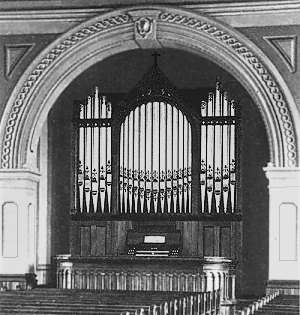Johnson Organs
The William A. Johnson Organ Company of Westfield, Massachusetts, which later became Johnson & Son Organ Company, was a highly respected firm that built 860 pipe organs throughout the United States and in Canada and Bermuda. The company operated from 1844 through 1898. All Johnson organs were completely mechanical (tracker action) organs, with Barker lever tracker-pneumatic actions utilized in larger organs after 1871.
History
In 1843, William Allen Johnson operated a contracting business in Westfield, Massachusetts. While he was completing the construction of a new church building for his own Westfield church, an organ builder of the firm E. and G.G. Hook & Hastings arrived with wagon loads of parts, pipes and materials which were to be installed in the new church. When asked about the availability of a worker to help set up the organ, Mr. Johnson readily applied for the job.
During the construction of the Hook organ, Johnson became interested in the art of organ building. The following winter he built a small parlor organ of just one rank. He continued his new craft, building seven more parlor organs in the next five years. In 1848, he built two small one-manual church organs of five or six ranks.

Continuing with church organ construction, Johnson built organs of increasing size. His first two-manual organ was Opus 13, 1849, at the Congregational Church in Westfield, Massachusetts. This organ contained about 15 ranks. Further expanding his territory and size, Opus 40, a 34-stop three-manual organ, was built in 1855 for the Park Presbyterian Church in Troy, New York. Another 1855 organ is believed to be the oldest Johnson organ which still exists in its original form. It is Johnson's Opus 43, built at the First Ward Presbyterian Church (later the Westminster Presbyterian Church) in Syracuse, New York.
In 1871, a fire destroyed the Johnson factory. All tools and materials, along with Opus 348, 349, and 350 that were under construction were destroyed. At the time of the fire, Opus 345, a typical William Johnson tracker pipe organ of about 18 ranks (Pictured) was being installed at the First Baptist Church of Penn Yan, New York. Most of its pipework, some the last to be built at the original factory, is still in use in the Church's present organ.
After the fire, an old Westfield church building was utilized for a factory. About that time William A. Johnson's son William H. Johnson, who had worked in the shop since he was 16, became an official member of the firm. With a new name, "Johnson and Son", the company was back in operation soon enough to produce 52 new organs in Chicago, Illinois, after the 1871 Great Chicago Fire. A new factory was built in 1873, and another in the mid-1880s. Johnson and Son continued the work of the William A. Johnson Organ Company, building an additional 500 organs. Their largest organs were of around 55 ranks.
Throughout the years, Johnson organs were well known for their "excellent balance, splendid dignity, and beautiful voicing". Highest quality materials and workmanship were used, and Johnson's organ pipes were always of the finest quality. Tracker organs eventually became less popular, and, not wishing to switch to tubular-pneumatic- or electro-pneumatic-action organs, the company ceased operations in 1898. Their last organ was a large 3-manual organ, Opus 860, at St. Paul's Church in Chicago.
References / Citation
All information in this article comes from this book:
- Elsworth, John Van Varick. The Johnson Organs, 1984, published by The Boston Organ Club of the Organ Historical Society.
External links
- Video clip Johnson & Son Pipe Organ at Saint Stanislaus, Buffalo, New York. Opus 797, 1893
- Web site History of rebuilt William A. Johnson organ, Opus 345 (1871) at First Baptist Church, Penn Yan, New York. Contains specification and links to photos. Retrieved 01/31/2011
- Web site History of extant Johnson & Son organ, Opus 690 (1888) at Lincoln Park Presbyterian Church, Chicago, Illinois. Contains specification and additional company information. Retrieved 01/31/2011